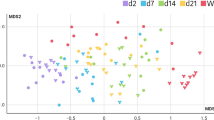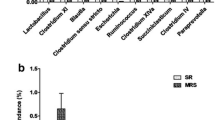Abstract
Weaning of the pig is generally regarded as a stressful event which could lead to clinical implications because of the changes in the intestinal ecosystem. The functional properties of microbiota inhabiting the pig’s small intestine (SI), including lactobacilli which are assumed to exert health-promoting properties, are yet poorly described. Thus, we determined the ecophysiology of bacterial groups and within genus Lactobacillus in the SI of weaning piglets and the impact of dietary changes. The SI contents of 20 piglets, 4 killed at weaning (only sow milk and no creep feed) and 4 killed at 1, 2, 5, and 11 days post weaning (pw; cereal-based diet) were examined for bacterial cell count and bacterial metabolites by fluorescence in situ hybridization (FISH). Lactobacilli were the predominant group in the SI except at 1 day pw because of a marked reduction in their number. On day 11 pw, bifidobacteria and E. coli were not detected, and Enterobacteriaceae and members of the Clostridium coccoides/Eubacterium rectale cluster were only found occasionally. L. sobrius/L. amylovorus became dominant species whereas the abundance of L. salivarius and L. gasseri/johnsonii declined. Concentration of lactic acid increased pw whereas pH, volatile fatty acids, and ammonia decreased. Carbohydrate utilization of 76 Lactobacillus spp. isolates was studied revealing a shift from lactose and galactose to starch, cellobiose, and xylose, suggesting that the bacteria colonizing the SI of piglets adapt to the newly introduced nutrients during the early weaning period. Identification of isolates based on partial 16S rRNA gene sequence data and comparison with fermentation data furthermore suggested adaptation processes below the species level. The results of our study will help to understand intestinal bacterial ecophysiology and to develop nutritional regimes to prevent or counteract complications during the weaning transition.


Similar content being viewed by others
References
Amann RI, Binder BJ, Olson RJ, Chisholm SW, Devereux R, Stahl DA (1990) Combination of 16S ribosomal-RNA-targeted oligonucleotide probes with flow-cytometry for analyzing mixed microbial-populations. Appl Environ Microbiol 56:1919–1925
Bach Knudsen KE (1997) Carbohydrate and lignin contents of plant materials used in animal feeding. Anim Feed Sci Technol 67:319–338
Bailey M, Haverson K (2006) The postnatal development of the mucosal immune system and mucosal tolerance in domestic animals. Vet Res 37:443–453
Bateup J, Dobbinson S, Munro K, McConnell MA, Tannock GW (1998) Molecular analysis of the composition of Lactobacillus populations inhabiting the stomach and caecum of pigs. Microb Ecol Health Dis 10:95–102
Bauer E, Williams BA, Smidt H, Verstegen MW, Mosenthin R (2006) Influence of the gastrointestinal microbiota on development of the immune system in young animals. Curr Issues Intest Microbiol 7:35–51
Benjamini Y, Hochberg Y (1995) Controlling the false discovery rate—a practical and powerful approach to multiple testing. J R Stat Soc B 57:289–300
Benjamini Y, Hochberg Y (2000) On the adaptive control of false discovery rate in multiple testing with independent statistics. J Educ Behav Stat 25:60–83
Berg RD (1996) The indigenous gastrointestinal microflora. Trends Microbiol 4:430–435
Boyd MA, Antonio MAD, Hillier SL (2005) Comparison of API 50 CH strips to whole-chromosomal DNA probes for identification of Lactobacillus species. J Clin Microbiol 43:5309–5311
Castillo M, Skene G, Roca M, Anguita M, Badiola I, Duncan SH, Flint HJ, Martín-Orúe SM (2007) Application of 16S rRNA gene-targeted fluorescence in situ hybridization and restriction fragment length polymorphism to study porcine microbiota along the gastrointestinal tract in response to different sources of dietary fibre. FEMS Microbiol Ecol 59:138–146
Dal Bello F, Hertel C (2006) Oral cavity as natural reservoir for intestinal lactobacilli. Syst Appl Microbiol 29:69–76
DeSantis TD, Hugenholtz P, Keller K, Brodie EL, Larsen N, Piceno YM, Phan R, Andersen GL (2006) NAST: a multiple sequence alignment server for comparative analysis of 16S rRNA genes. Nucleic Acids Res 34:W394–399
Duncan SH, Louis P, Flint HJ (2004) Lactate-utilizing bacteria, isolated from human feces, that produce butyrate as a major fermentation product. Appl Environ Microbiol 70:5810–5817
Ehrmann MA, Kurzak P, Bauer J, Vogel RF (2002) Characterization of lactobacilli towards their use as probiotic adjuncts in poultry. J Appl Microbiol 92:966–975
Franks AH, Harmsen HJM, Raangs GC, Jansen GJ, Schut F, Welling GW (1998) Variations of bacterial populations in human faeces measured by fluorescent in situ hybridization with group specific 16S rRNA-targeted oligonucleotide probes. Appl Environ Microbiol 64:3336–3345
Guiard V (2004) Calculation of the q-values for a two stage step-up test procedure that controls the false discovery rate. Schriftenreihe des FBN Dummerstorf 14:31
Haacker K, Block H-J, Weissbach F (1983) Zur kolorimetrischen Milchsäurebestimmung in Silagen mit p-Hydroxydiphenyl. Archives of Animal Nutrition 33:505–512
Hartemink R, Rombouts FM (1999) Comparison of media for the detection of bifidobacteria, lactobacilli and total anaerobes from faecal samples. J Microbiol Methods 36:181–192
Heilig HGHJ, Zoetendal EG, Vaughan E, Marteau P, Akkermans ADL, de Vos WM (2002) Molecular diversity of Lactobacillus spp. and other lactic acid bacteria in the human intestine as determined by specific amplification of 16S ribosomal DNA. Appl Environ Microbiol 68:114–123
Hill JE, Hemmingsen SM, Goldade BG, Dumonceaux TJ, Klassen J, Zijlstra RT, Goh SH, Van Kessel AG (2005) Comparison of ileum microflora of pigs fed corn-, wheat-, or barley-based diets by chaperonin-60 sequencing and quantitative PCR. Appl Environ Microbiol 71:867–875
Hopwood DE, Hampson DJH (2003) Interactions between the intestinal microflora, diet and diarrhoea, and their influences on piglet health in the immediate post-weaning period. In: Pluske JR, Le Dividich J, Verstegen MWA (eds) Weaning the pig—concepts and consequences. Wageningen Academic Publishers, The Netherlands, pp 199–218
Isolauri E, Kirjavainen PV, Salminen S (2002) Probiotics: a role in the treatment of intestinal infection and inflammation? Gut 50:54–59
Janczyk P, Pieper R, Souffrant WB, Smidt H (2007) Changes in the diversity of pig ileal lactobacilli around weaning determined by means of 16S rRNA-gene amplification and denaturant gradient gel electrophoresis. FEMS Microbiol Ecol 61(1):132–140.
Konstantinov SR, Awati A, Smidt H, Williams BA, Akkermans ADL, de Vos WA (2004) Specific response of a novel and abundant Lactobacillus amylovorus-like phylotype to dietary prebiotics in the guts of weaning piglets. Appl Environ Microbiol 70:3821–3830
Konstantinov SR, Poznanski E, Fuentes S, Akkermans ADL, Smidt H, de Vos WM (2006a) Lactobacillus sobrius sp nov., abundant in the intestine of weaning piglets. Int J Syst Evol Microbiol 56:29–32
Konstantinov SR, Awati AA, Williams BA, Miller BG, Jones P, Stokes CR, Akkermans ADL, Smidt H, de Vos WM (2006b) Post-natal development of the porcine microbiota composition and activities. Environ Microbiol 8:1191–1199
Lalles JP, Boudry G, Favier C, Le Floch N, Lurona I, Montagne L, Oswald IP, Pie S, Piel C, Seve B (2004) Gut function and dysfunction in young pigs: physiology. Anim Res 53:301–316
Langendijk P, Schut F, Jansen G, Raangs G, Kamphuis G, Wilkinson M, Welling GW (1995) Quantitative fluorescence in situ hybridization of Bifidobacterium spp. with genus specific 16S rRNA-targeted probes and its application in fecal samples. Appl Environ Microbiol 61:3069–3075
Leser TD, Amenuvor JZ, Jensen TK, Lindecrona RH, Boye M, Moller K (2002) Culture-independent analysis of gut bacteria: the pig gastrointestinal tract microbiota revisited. Appl Environ Microbiol 68:673–690
Ludwig W, Strunk O, Westram R, Richter L, Meier H, Yadhukumar, Buchner A, Lai T, Steppi S, Jobb G, Forster W, Brettske I, Gerber S, Ginhart AW, Gross O, Grumann S, Hermann S, Jost R, Konig A, Liss T, Lussmann R, May M, Nonhoff B, Reichel B, Stehlow R, Stamatakis A, Stuckmann N, Vilbig A, Lenke M, Ludwig T, Bode A, Schleifer KH (2004) ARB: a software environment for sequence data.. Nucleic Acids Res 32:1363–1371
Makarova KS, Koonin EV (2007) Evolutionary genomics of lactic acid bacteria. J Bacteriol 189:1199–1208
Manz W, Amann R, Ludwig W, Vancanneyt M, Schleifer KH (1995) Application of a suite of 16S rRNA-specific oligonucleotide probes designed to investigate bacteria of the phylum cytophaga-flavobacter-bacteroides in the natural environment. Microbiology 142:1097–1106
Mare L, Wolfaardt GM, Dicks LM (2006) Adhesion of Lactobacillus plantarum 423 and Lactobacillus salivarius 241 to the intestinal tract of piglets, as recorded with fluorescent in situ hybridization (FISH), and production of plantaricin 423 by cells colonized to the ileum. J Appl Microbiol 100:838–845
Molenaar D, Bringel F, Schuren FH, de Vos WM, Siezen RJ, Kleerebezem M (2005) Exploring Lactobacillus plantarum genome diversity by using microarrays. J Bacteriol 187:6119–6127
Montagne L, Boudry G, Favier C, Le Huërou-Luron I, Lallès JP, Sève B (2007) Main intestinal markers associated with the changes in gut architecture and function in piglets after weaning. Br J Nutr 97:45–57
Park SH, Itoh K (2005) Species-specific oligonucleotide probes for the detection and identification of Lactobacillus isolated from mouse faeces. J Appl Microbiol 99:51–57
Pluske JR, Hampson DH, Williams IH (1997) Factors influencing the structure and function of the small intestine in the weaned pig: a review. Livest Prod Sci 51:215–236
Pluske JR, Montagne L, Cavaney FS, Mullan BP, Pethick DW, Hampson DJ (2007) Feeding different types of cooked white rice to piglets after weaning influences starch digestion, digesta and fermentation characteristics and the fecal shedding of b-haemolytic Escherichia coli. Br J Nutr 97:298–306
Pot B, Hertel C, Ludwig W, Descheemaeker P, Kersters K, Schleifer KH (1993) Identification and classification of Lactobacillus acidophilus, L. gasseri and L. johnsonii strains by SDS-PAGE and rRNA-targeted oligonucleotide probe hybridization. J Gen Microbiol 139:513–517
Poulsen LK, Licht TR, Rang C, Krogfelt A, Molin S (1995) Physiological state of Escherichia coli BJ4 growing in the large intestines of streptomycin-treated mice. J Microbiol 177:5840–5845
Sghir A, Antonopoulos D, Mackie RI (1998) Design and evaluation of a Lactobacillus group-specific ribosomal RNA-targeted hybridization probe and its application to the study of intestinal microecology in pigs. Syst Appl Microbiol 21:291–296
Sghir A, Gramet G, Suau A, Rochet V, Pochart P, Dore J (2000) Quantification of bacterial groups within human fecal flora by oligonucleotide probe hybridization. Appl Environ Microbiol 66:2263–2266
Spreeuwenberg MAM, Verdonk JMAJ, Gaskins HR, Verstegen MWA (2001) Small intestine epithelial barrier function is compromised in pigs with low feed intake at weaning. J Nutr 131:1520–1527
Storey JD, Tibshirani R (2003) Statistical significance for genomewide studies. Proc Nat Acad Sci U S A 100:9440–9445
Vogel RF, Bocker G, Stolz P, Ehrmann M, Fanta D, Ludwig W, Pot B, Kersters K, Schleifer KH, Hammes WP (1994) Identification of lactobacilli from sourdough and description of Lactobacillus pontis sp. nov. Int J Syst Bacteriol 44:223–229
Voigt J, Steger H (1967) Zur quantitativen Bestimmung von Ammoniak, Harnstoff und Ketokörpern in biologischem Material mit Hilfe eines modifizierten Mikrodiffusionsgefässes. Archives of Animal Nutrition 17:289–293
Wall R, Fitzgerald G, Hussey S, Ryan T, Murphy B, Ross P, Stanton T (2006) Genomic diversity of cultivable Lactobacillus populations residing in the neonatal and adult gastrointestinal tract. FEMS Microbiol Ecol 59:127–137
Wallner G, Amann R, Beisker W (1993) Optimizing fluorescent in situ hybridization with rRNA-targeted probes for flow cytometric identification of microorganisms. Cytometry 14:136–143
Zoetendal EG, Ben Amor K, Harmsen HJ, Schut F, Akkermans ADL, de Vos WM (2002) Quantification of uncultured Ruminococcus obeum-like bacteria in human fecal samples by fluorescent in situ hybridization and flow cytometry using 16S rRNA-targeted probes. Appl Environ Microbiol 68:4225–4232
Zoetendal EG, Collier CT, Koike S, Mackie RI, Gaskins HR (2004) Molecular ecological analysis of the gastrointestinal microbiota: a review. J Nutr 134:465–472
Acknowledgements
We are grateful to our technicians Marlies Althaus, Sonja Bruesch, Aenne Koepnick, Ingetraut Prignitz, Hannelore Sievert, Brigitte Wuerfel, Walter Booth, Roland Gaeth, Niels Burzan, and Manfred Kwella for the animal care and excellent laboratory assistance. The European Union is greatly acknowledged for the financial support of the project FEED FOR PIG HEALTH (FOOD-CT-2004-506144). The authors are solely responsible for the text which does not represent the opinion of the EU, and the EU is not responsible for the information delivered.
Author information
Authors and Affiliations
Corresponding author
Additional information
Dr. Volker Guiard has passed away.
Robert Pieper and Pawel Janczyk contributed equally to this work.
Rights and permissions
About this article
Cite this article
Pieper, R., Janczyk, P., Zeyner, A. et al. Ecophysiology of the Developing Total Bacterial and Lactobacillus Communities in the Terminal Small Intestine of Weaning Piglets. Microb Ecol 56, 474–483 (2008). https://doi.org/10.1007/s00248-008-9366-y
Received:
Revised:
Accepted:
Published:
Issue Date:
DOI: https://doi.org/10.1007/s00248-008-9366-y




